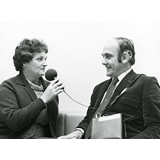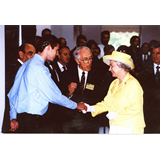Person
Saunders, Rod

Photograph showing Rod Saunders speaking with his wife using the first speech processor developed by the University of Melbourne's Department of Otolaryngology, courtesy of Graeme Clark Foundation website http://graemeclarkfoundation.org/how-the-cochlear-implant-bionic-ear-functions/.
Details
Rod Saunders speaks with his wife Margaret with his new wearable speech processor, 1979, courtesy of Graeme Clark.
Details
Summary
Rod Saunders was the first person to have their hearing restored and understand speech with the aid of a cochlear implant (bionic ear). Saunders received the implant in a surgical procedure conducted by Graeme Clark at the Royal Victorian Eye and Ear Hospital in Melbourne on 1 August 1978.
Related entries
Archival resources
National Library of Australia Manuscript Collection
- Papers of Graeme M. Clark, 1944-2012 [manuscript], 1944 - 2012, MS 8696; National Library of Australia Manuscript Collection. Details
The University of Melbourne Archives
- Department of Otolaryngology - Bionic Ear Records, 1949 - 2000, 2004.0043 at U77/46-55; The University of Melbourne Archives. Details
Published resources
Books
- Worthing, Mark, Graeme Clark: The Man Who Invented the Bionic Ear (Crows Nest: Allen & Unwin, 2015), 221 pp. Details
Resources
- 'Saunders, Rod', Trove, National Library of Australia, 2009, https://nla.gov.au/nla.party-1772567. Details
Digital resources

- Title
- Photograph showing Rod Saunders speaking with his wife using the first speech processor developed by the University of Melbourne's Department of Otolaryngology
- Type
- Image
- Source
- Graeme Clark Foundation website http://graemeclarkfoundation.org/how-the-cochlear-implant-bionic-ear-functions/

- Title
- Rod Saunders speaks with his wife Margaret with his new wearable speech processor
- Type
- Image
- Date
- 1979
- Source
- Graeme Clark
Jack Roberts
Created: 26 June 2016, Last modified: 10 October 2016

